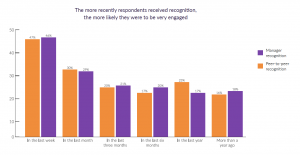Everyone hates annual employee evaluations, but I don’t think that’s a big secret.
Many employees dread their upcoming evaluation for weeks or months in advance — and whether they’re willing to admit it or not — most managers hate employee evaluations as much or more than employees do.
But everyone continues suffering through them as though they’re an unappealing, yet necessary task for organizational health. In fact, according to a recent SHRM study, as many as 72 percent of companies still conduct an annual employee appraisal.
Although it might be equally uncomfortable, an employee evaluation isn’t like a root canal — there’s not often a tangible benefit at the end of the procedure.
In a surprisingly large number of cases, you’re left worse off than where you started.
Middle managers, team leads, and employees of all types have voiced their apprehensiveness toward annual evaluations. In his Psychology Today column, “Wired for Success,” Ray Williams shared the results of a People IQ 2005 survey, in which 87 percent of both managers and employees believed annual reviews were ineffective, and not useful.
So why do we conduct evaluations at all? What is it about this process that so many organizations find attractive, and how has it lasted so long?
In many cases, it’s a symptom of the ‘this is how we’ve always done it’ or ‘if it isn’t broken, don’t fix it’ mindset. That’s unfortunate, because in most cases it is broken.
It’s time to fix it.
This isn’t a new concept. Organizations of all sizes across the world are beginning to abandon annual employee evaluations for more effective and productive strategies.
Senior leadership in many successful organizations voiced their concern that these evaluations are costly, and provide little, if any real benefit in return.
Unfortunately, there are also many cases where a company will make a commitment to abandon their outdated employee review process, only to continue administering it by another name. A name change is not going to be good enough, though.
It’s time to rethink employee evaluations, and here are a few reasons why:
They’re an overly simplistic measurement for a complicated subject.

One of the greatest failings of the employee evaluation is its attempt to summarize the value of an employee’s contributions, often within a small numerical range.
In her Morning Edition episode ‘Behold The Entrenched — And Reviled — Annual Review,’ Yuki Noguchi explains:
“Companies started embracing the review system in the 1960s and ’70s, hoping to manage bigger workforces more effectively. They needed a uniform grading system.”
This is extraordinarily problematic, because the end result of that search for a uniform grading system was the five point scale — probably the world’s worst candidate for measuring human potential.
On a five point scale, there’s no room for context.
A single digit can account for a huge difference in the score’s perceived meaning, and that’s only a small part of the problem. A whole host of complications arise when you try to shoehorn a human being into a standardized mold.
For a literal interpretation, there’s an excellent episode of 99% Invisible that details the history of fit standards, the one-size-fits all fallacy, and how breaking from those standards not only improved results, in some cases it saved lives.
Todd Rose, the Harvard Graduate School of Education’s Director of the Mind, Brain, & Education shares some fascinating insights on this topic on the TEDx stage:
Science tells us even great employees are crushed by receiving negative feedback.

It’s a common belief that the feedback employees receive during their annual evaluation is constructive — that it’s providing them with a learning opportunity, and some much-needed insight into key areas of growth. Employees with a desire for self-improvement and a willingness to learn can take that feedback and become better at their job.
Unfortunately, that’s only a belief. In many cases, the opposite is true.
In her summary of some fascinating research carried out by scientists at Kansas State University, Eastern Kentucky University and Texas A&M University, the Washington Post’s Jenna McGregor explains how in the context of a performance review, that ‘constructive criticism’ doesn’t really help build anyone up. Instead, it deflates even those employees who might be considered its ideal recipients:
“Those who like to learn—presumably some of the best employees—were significantly bothered by the negative feedback they received.”
It’s not about having thick or thin skin. Even elements of a performance review that aren’t intended by the manager to be critical are often perceived that way. McGregor goes on to say that:
“…managers need to be especially careful that what’s intended as praise doesn’t get misconstrued as criticism. This particularly applies to performance ratings, which HR professionals often plot along a bell curve and use to classify employees’ performance.”
A study of over 1,000 millennial employees conducted by TriNet found that after exiting their annual performance review, half of the respondents felt as though they couldn’t do anything right.
Josh Bersin notes in his recent Forbes article, “Time to Scrap Performance Appraisals?”
“People are inspired and motivated by positive, constructive feedback – and the ‘appraisal’ process almost always works against this.”
It’s not just wasted work; it’s work done counter to organizational goals.
Employees are coming out, not with a brilliantly delivered insight into their path to growth, but with a sense of disappointment and lack of self-esteem that often translates to decreased performance.
Evaluations are traditionally one-sided.

The annual performance review doesn’t just rob employees of an opportunity to share their unique side of the story. It robs managers of an opportunity to learn more about the environment they’re cultivating, and to find otherwise hidden ways to move their organization forward.
That’s a huge.
An employee’s manager or leader has a significant impact on the outcome of their work and their ultimate place in the organization. That impact can be positive or negative.
Nobody wants to be a bad boss, but good intentions aren’t enough. There are a lot of well-intentioned, but misguided bosses out there.
A constant multidirectional flow of communication isn’t just useful in helping employees achieve their highest aspirations; it can help managers and leaders reach a higher level of competency as well.
Research by Utah Valley Univeristy showed less than a third of organizations provided excellent leadership and communication skills training for managers.
When you consider the impact a manager or leader can have across an organization, it’s clear that we should provide them with every opportunity to improve their competencies — whether in soft skills, or others.
Better communication can help leaders and managers expand on their own competencies, and in turn help their team to do the same.
No matter how hard you try, evaluations will always be subjective.

In his lightning-rod feature for the Wall Street Journal, leadership expert Samuel A. Culbert details one of the annual employee evaluation’s greatest flaws. Behind the veil of objective measurement the 1-5 scale provides, there will always be an inescapable layer of subjectivity that exists:
“In almost every instance what’s being ‘measured’ has less to do with what an individual was focusing on in attempting to perform competently and more to do with a checklist expert’s assumptions about what competent people do.”
The Idiosyncratic Rater Effect, published by The Marcus Buckingham company reveals that “61% of a performance rating is a reflection of the rater, not the ratee.”
We try to be as objective as possible by breaking down a year’s contributions into a matrix, or series of simple scores — but the fact still remains: managers are human.
Different raters have a consistent propensity to give different ratings to the same person.
This can be extraordinarily problematic when the results of these evaluations are tied to employee compensation and career advancement.
5. Some evaluation frameworks derail teamwork and pit employees against one another.

In a case developed for a course on scaling organizational change, the Stanford Graduate School of Business detailed the history of Adobe’s employee evaluation practices, and the successful restructuring it underwent.
There were several key findings in the case, one of which was the counter-effective nature of stack ranking:
“With stack ranking, Adobe employees felt compelled to strategically ensure they ranked among the top 15 percent…Employees attempted to maximize individual success, often at the expense of the team…stack ranking threatened effective teamwork and collaboration because it pitted employees against one another.”
Because only a certain percentage of employees are able to be listed as top performers, many employee evaluation practices that feature a stacked ranking system are at risk of harming the health of the organizational atmosphere.
6. Better, more effective tools already exist.

If it’s so problematic, what do we replace the annual employee evaluation with?
You don’t have to immediately resort to a dramatic shift, and sometimes that option isn’t even on the table. That’s okay though.
Many of the most negative aspects of the annual employee performance review can be mitigated, simply by exhibiting a more frequent cadence of check-ins throughout the year.
As part of a panel discussion during the panel discussion at our recent “The Future of Work: Talent and Culture for the 21st Century,” event, Jonathan Basker explained that the annual review isn’t the problem all by itself.
It’s when that review becomes the singular management moment between an employee and the person who is supposed to be dedicated to helping them achieve their best:
“If you manage people, make sure you’ve internalized the obligation you have to these other human beings, how much you affect someone else’s life, and the responsibility that comes with that, whether you like it or not.
If you have a problem with that, stop being a manager. You owe those people the growth they’re looking for — the environment and life they’re looking for.”
Here are a few examples of tools you can use that will help you make good on that obligation:
360 Reviews: An employee review can become much more effective and useful when it’s no longer one-sided. 360 reviews are becoming more and more common across modern businesses, especially as the competition heats up for top talent, and organizational performance.
Our friends at Small Improvements have a great tool for 360 reviews, if you’re looking for an easy way to implement and track them.
Peer Recognition: Although it isn’t exactly a formal review process, peer recognition is a great way for employees to gain an understanding of which of their contributions impact the organization most positively.
Because it’s often given on a regular cadence, peer recognition can also help avoid the ‘blindsiding’ effect some employee evaluations can have.
If you’re using a system like Bonusly that tracks and catalogs these interactions, it can be an extraordinarily useful record to look back on during more comprehensive long-term reviews.
Regular One-on-One Meetings: We recently published an article on the positive impact one-on-one meetings have had on our management relationships, plus some great tips on improving their effectiveness.
In Conclusion:
Although the annual employee evaluation is fairly entrenched across many organizations, it has proven not to be as useful a tool as it was promised to be decades ago.
Fortunately, there are many great alternatives to the annual review, and some excellent strategies for improvement when it can’t be replaced.
Let’s take a moment to recap with this infographic:

Ready to take the next step in building an extraordinary company culture? Check out our latest guide:
Business & Finance Articles on Business 2 Community
(90)
Report Post







